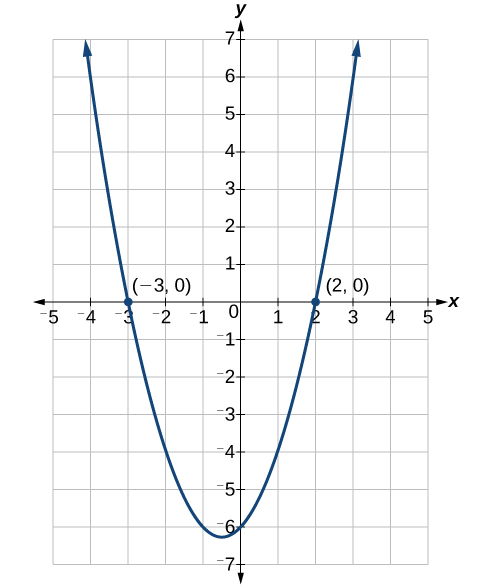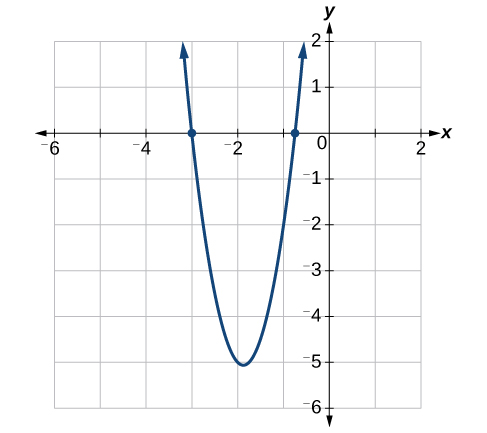The Zero-Product Property and Quadratic Equations
The
zero-product property states
If a⋅b=0, then a=0 or b=0
where
a and
b are real numbers or algebraic expressions.
A
quadratic equation is an equation containing a second-degree polynomial; for example,
ax2+bx+c=0
where
a,
b, and
c are real numbers, and if
a=0, it is in standard form.
Example
Factor and solve the equation:
x2+x−6=0.
Answer:
To factor x2+x−6=0, we look for two numbers whose product equals −6 and whose sum equals 1. Begin by looking at the possible factors of −6.
1⋅(−6)(−6)⋅12⋅(−3)3⋅(−2)
The last pair,
3⋅(−2) sums to
1, so these are the numbers. Note that only one pair of numbers will work. Then, write the factors.
(x−2)(x+3)=0
To solve this equation, we use the zero-product property. Set each factor equal to zero and solve.
(x−2)=0x=2(x−2)(x+3)=0(x+3)=0x=−3
The two solutions are
x=2 and
x=−3.
If we graph the function
f(x)=x2+x−6, we will get the parabola in the figure below. The solutions to the equation
x2+x−6=0 are the
x-intercepts of the function
f(x)=x2+x−6. Recall that x-intercepts are where the outputs, or y values are zero, therefore the points
(−3,0) and
(2,0) represent the places where the parabola crosses the x axis.

In the following video, we provide more examples of factoring to solve quadratic equations.
https://youtu.be/bi7i_RuIGl0
In our next example, we will solve a quadratic equation that is written as a difference of squares.
Example
Solve the difference of squares equation using the zero-product property:
x2−9=0.
Answer:
Recognizing that the equation represents the difference of squares, we can write the two factors by taking the square root of each term, using a minus sign as the operator in one factor and a plus sign as the operator in the other. Solve using the zero-factor property.
(x−3)=0x=3x2−9=0(x+3)=0x=−3
The solutions are x=3 and x=−3.
Example
Use grouping to factor and solve the quadratic equation:
4x2+15x+9=0.
Answer:
First, multiply ac:4(9)=36. Then list the factors of 36.
1⋅362⋅183⋅124⋅96⋅6
The only pair of factors that sums to
15 is
3+12. Rewrite the equation replacing the
b term,
15x, with two terms using
3 and
12 as coefficients of
x. Factor the first two terms, and then factor the last two terms.
4x2+3x+12x+9=0x(4x+3)+3(4x+3)=0(4x+3)(x+3)=0
Solve using the zero-product property.
(4x+3)=0x=−43(4x+3)(x+3)=0(x+3)=0x=−3
The solutions are
x=−43,
x=−3.

The following video contains another example of solving a quadratic equation using factoring by grouping.
https://youtu.be/04zEXaOiO4U
Sometimes, we may be given an equation that does not look like a quadratic at first glance. In our next examples we will solve a cubic polynomial equation where the GCF of each term is x and can be factored. The result is a quadratic equation that we can solve.
Example
Solve the equation by factoring:
−3x3−5x2−2x=0.
Answer:
This equation does not look like a quadratic, as the highest power is 3, not 2. Recall that the first thing we want to do when solving any equation is to factor out the GCF, if one exists. And it does here. We can factor out −x from all of the terms and then proceed with grouping.
−3x3−5x2−2x=0−x(3x2+5x+2)=0
Use grouping on the expression in parentheses.
−x(3x2+3x+2x+2)=0−x[3x(x+1)+2(x+1)]=0−x(3x+2)(x+1)=0
Now, we use the zero-product property. Notice that we have three factors.
−x=0x=0(3x+2)=0x=−32(x+1)=0x=−1
The solutions are
x=0,
x=−32, and
x=−1.
In this last video example, we solve a quadratic equation with a leading coefficient of -1 using a shortcut method of factoring and the zero product principle.
https://youtu.be/nZYfgHygXis


